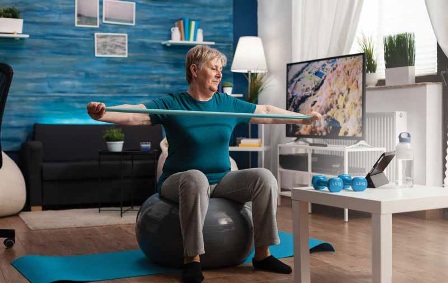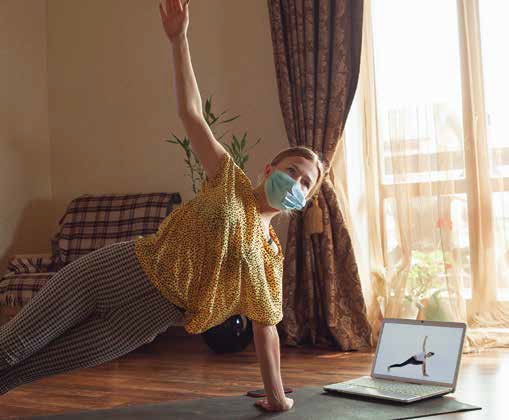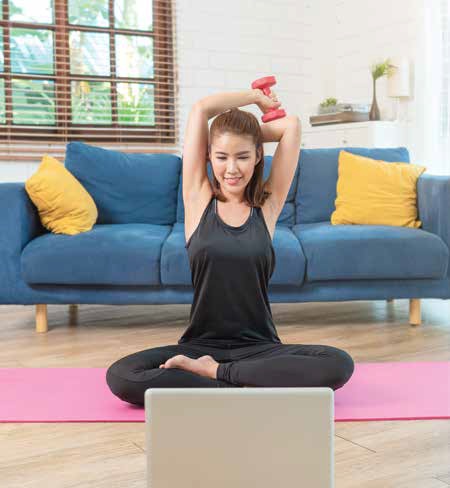Rehabilitation, the process of restoring an individual to health or normal life through training and therapy, is a major component of health sciences. Rehabilitation services have been disrupted due to the COVID-19 pandemic. Even with unlocking and post vaccination, some form of physical distancing is likely to be part of the new normal. This review suggests that Tele-rehabilitation (TR) will soon be a distinct standalone sub speciality of Telehealth and is here to stay.

Globally, 2.4 billion people would benefit from some form of rehabilitation. Rehabilitation services help maintain, restore, or improve skills for Activities of Daily Life. These could have been lost or impaired because a person was sick, hurt or living with temporary or permanent disability. Illustrations of rehabilitation include exercises to improve speech, language and communication after a brain injury and modifying home environment to improve safety and independence at home, thus reducing risk of falls. Other examples include exercise training and education for healthy living, making, fitting and educating an individual to use a prosthesis, reducing muscle stiffness for a child with cerebral palsy and training in use of a white cane, for a person with vision loss.
Introduction to tele-rehabilitation Services
Digitalisation of healthcare is at an all-time high, as is the exponential growth of telehealth. TR is “the delivery of rehabilitation services via information and communication technologies”. Reduced access to in-person rehabilitation, secondary to the pandemic, is resulting in TR growing exponentially. Patients may be too ill to travel or have difficulty in mobility. Adverse weather conditions, challenges in identifying mutually convenient session times, household responsibilities and occupational commitments may make travelling difficult. TR services include evaluation, assessment, monitoring, prevention, intervention, supervision, education, consultation, and coaching. TR services can be deployed across patient populations and multiple healthcare settings including clinics, homes, schools and community-based worksites. A Fortune Business Insights Report estimated a market value of US$3.32 billion in 2019, with a Compounded Annual Growth Rate (CAGR) of 13.4 per cent leading to US$9.13 billion by 2027.
Advantages and barriers in telerehabilitation
These include exercising from comfort of home, ability to work on one’s recovery irrespective of time schedule of health care professionals and improved quality of exercise instruction, as they are available for repeated review on video format. Access to high-quality care despite geographical isolation, reduced travel and waiting time, flexibility, and costeffectiveness are additional benefits Limited computer literacy, unreliable internet connection, language barrier, inability to perform an actual physical assessment, patient privacy, and safety concerns are challenges Some participants were enthusiastic about TR as they could be in contact with their therapist and continue training.
Methods and components of Telerehabilitation
These include physical, motor therapy, occupational therapy, speechlanguage audiology, deployment of virtual reality (VR), tele-robotic therapy and gamification. Webcams, videoconferencing tools, asynchronous e-visits, virtual check-ins, remote evaluations of recorded videos or images, telephonic assessment and management services can also be used. Machines interfaced with robotic arms, robotic legs, data gloves and smart glasses in a 3D environment allow for greater sense of immersion. Defining patient’s diagnosis for a correct therapeutic programme, visualisation in video format of catalog of preloaded exercises and creation of new ones along with maximum personalisation and customisation of TR programmes is desirable.

Tele-rehabilitation setting
Background: This should be appropriate with adequate lighting, no background noise or interruptions. Professional clinical attire is recommended. The virtual visit should begin by getting an informed consent, ensuring adequate audio visual facilities and orienting the patient for a technical set up and a remote clinical examination. The former should include reliable internet, computer, headset, speakers, microphone, familiarity with chosen virtual platform, virtual follow-up appointments and training modules.
Challenges and Limitations in introducing Tele-rehabilitation
In low resource settings all needs cannot be met. Access to teleservices, reduced access to smart devices, computers, difficulty in using devices/software effectively and privacy concerns are often problems. Digital access to welfare benefits/ interventions may hurt those without internet access. Face to face services help in socialisation, building self-esteem, learning instrumental activities, mentorship and hands-on training. Non-availability of dependable power, network and, bandwidth and shortage of multimedia devices are major concerns. Insufficient training for professionals, licensing, liability, malpractice, confidentiality, cultural issues, environmental stigma, abuse, quackery, affordability, reduced intrinsic motivation, considering portal-mediated communication with HCP as ‘impersonal’and lack of physical space and rest to properly exercise at home compound the problem. Elderly require repeated instructions for TR. Suboptimal lighting, poor audibility, call drop, difficulty in remembering procedural steps, lag during conversation and difficulty in remote troubleshooting also need to be concerned. Therapists require to see the whole person on a screen, which is often difficult. Family members may find supervising home-based activities difficult.
Clinical indications for Telerehabilitation
Clinical indications for TR include musculoskeletal disorders, low back ache, spondylosis, osteoarthritis, neck pain, frozen shoulder and post joint replacement. Neurological conditions benefiting from TR include stroke, neurotrauma, neurodegenerative disorders, cerebral palsy, Post TB Meningitis, neuro muscular disorders, Gullian Barre syndrome, deuchenne muscular dystrophy and demyelinating diseases. Chronic obstructive pulmonary disorders (COPD), post-ICU conditions, post Covid, cardiovascular disorders, visual, hearing, developmental disorders, speech and voice dysfunction, swallowing disorders and cognitive dysfunction also benefit from TR. Virtual assessments for pain, swelling, range of motion, muscle strength, balance, gait, and functional assessment demonstrated good concurrence with physical assessments. TR can provide high‑quality personalised musculoskeletal physiotherapy. Knee osteoarthritis causes musculoskeletal pain and disability affects up to one‑third of people aged over 60 years. Remote muscle strengthening exercises can significantly reduce pain, improve physical function and quality of life. TR for musculoskeletal conditions leads to reduced hospitalisation and crowding in physiotherapy departments. Musculoskeletal Disorders (MSDs) are the second commonest cause of chronic pain and physical disabilities. Physiotherapy assessments that can be done through video include evaluation of pain, swelling, range of motion, muscle strength, balance, gait and functional assessment.
TR for stroke, cardiac, pulmonary afflictions, and swallowing difficulties
A study of 22 trials involving 1937 patients from systematic reviews in the Cochrane Database System on use of TR systems found moderate-quality evidence that there was no difference in activities of daily living between people who received a post-hospital TR intervention and those who received usual care. Significantly different outcomes between the groups, have not been found, suggesting that TR is not inferior.TR is an excellent rehab measure for COPD patients who can exercise at home, while being monitored from tertiary care centres. Recent literature has shown that TR for pulmonary afflictions is as effective as inpatient pulmonary rehab programmes. In a recent publication, follow‑up and counselling was effective through telephone and social media Facebook, Twitter and e‑mail). Cardiac tele-rehabilitation includes bicycles with touch screens and wireless sensors to check the patients’ ECG, blood pressure, and oxygen saturation in real time. At the hospital, the supervising staff can connect remotely to the patient’s computer touch screen to customise the exercises based on previous exercise stress test and monitor patient’s health condition in real time, during rehabilitation. Exercises can be stopped if abnormal values are detected. The machine could be interfaced with devices such as robotic arms, robotic legs, data gloves, and smart glasses. Such smart devices are used in a 3-dimensional environment simulation, allowing greater sense of immersion in the virtual environment. A sophisticated TR application used a realtime video fluoroscopic examination via the Internet. This system enabled the capture and display of images in realtime with only a three to five second delay. There has been considerable research into assessment and treatment of dysphagia via TR, including cost analyses, leading to establishment of sustainable TR services

Tele-rehabilitation for children
TR for children presupposes adequate floor space for the child to demonstrate gross motor skills, including sitting, creeping, walking, running, jumping, and / or skipping as appropriate for age and development. Technical preparation before beginning, during and closing the virtual visit is essential. Close interaction with parents is critical
Tele-physiotherapy
A customised tele-physiotherapy (TP) programme is made by the physiotherapist who designs the exercise schedule, sets and repetitions for the patient to execute remotely. Details of exercise programme is provided through pre-recorded video material, accessed by mobile phone, tablet, computer or video calls. Traditional physical therapy involves physical touch used to guide, direct and facilitate movement. This humane factor could be reduced in TP. Incorporation of 3D VR systems with complex sensor systems help address this.
Tele-rehabilitation potential in India
India now has over 100 million senior citizens. The market for geriatric rehabilitation alone is high. Confederation of Indian Industries, in a report showed that 5.5 per cent of seniors were staying at homes. 6 per cent of seniors live alone. Of the 700 million active internet users, 70 per cent access the internet daily mostly using mobiles. Interestingly communication technology is growing faster in rural rather than urban areas. They were using smartphones in 2020. 77 per cent of 500 million smartphone users were accessing broadband services. The National Institute of Mental Health and Neuro Sciences (NIMHANS), services delivered tele-mental health services during the COVID-19 crisis to ensure continuity of care for patients who were unable to avail outpatient services.. A report on 22 senior citizens from four Community Centers in Delhi showed that home-based TR could be used as an adjunct to continue follow up care thus improving outcomes
Technology
In TR, technology support to ensure proper functioning is critical. User friendly technology, flexible, simple, intuitive, requiring low physical effort, with a tolerance for error and controlled remotely can do wonders. Remotely located patient centric devices should integrate with Communication and Software system, as beneficiaries may have impairments of fine/gross motor skill, cognition, speech, language, vision or hearing. Deployment of technology and its usability should be contextual. Virtual Reality (VR) allows development of 3D virtual environments with motion technology. Wireless sensors track the patient’s wrist and finger movements. The smart glove records kinematics of the patient’s wrist and fingers and streams sensor data to the data receiver the app allows engagement through instructional material (video, image, text) and also to video record patient performance. Computer-assisted cognitive rehabilitation systems and serious games for health are increasingly available. VR can recreate realistic environments in which patients may bodily operate. Wearable sensors allow quantitative monitoring of a patient’s performance.
Tele-rehabilitation: A peep into the future
TR will eventually be integrated with Smart Homes in Smart Cities. Functional monitoring with bed sensors, activity/motion sensors and gait monitors will be a reality. This will be followed by Creating a connected home with pressure-sensing floors, smart furniture and medical sensors. Assistive robots, power wheelchairs, prosthetic limb controls, Home Automation systems and AI Chatbot companion at Home will add value providing ‘smarter care’. This will include encouraging activities and contacting caregiver/children in emergencies. Staying@home, better known as ageing in place will lead to better health outcomes.
Conclusion
Understanding who will use TR, how it will help achieve customised, well defined and changing goals is critical. Beneficiary’s goals alone matter. TR is only a tool to achieve them. The healthcare provider using TR should get into the minds of the end user. It should never be forgotten that for digital natives, an octogenarian is from another planet. ‘Customer delight’ is not a cliché used as a marketing ploy. TR is not a solution searching for a problem. Nothing can stop an idea whose time has come. Covid has ensured that tele-rehabilitation is here to stay.